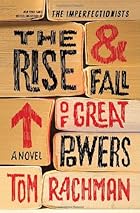Novelists who imagine their experiences rather than chronicling imaginary events.
Tuesday, May 20, 2014
Block Time: The Rise & Fall of Great Powers
The Rise & Fall of Great Powers is the second novel by Tom Rachman. His first novel, The Imperfectionists: A Novel, was a New York Times bestseller and I enjoyed reading it very much. This book is organized in self-contained blocks of time that have an intricate but seamless structure. The time periods are related to three decades in the life of Tooly Zyberberg: childhood, young adulthood, and full personhood. The calendar anchors are 1988, 2000, and 2011, and the reader falls in love with the developing Tooly in the context of economic hardship, the Millennium, and social evolution.
Tooly's first two decades of life are periods of unique experience and learning that are guided by Paul, Sarah, Venn, and Humphrey. Paul is a globe-trotting computer consultant, an introvert who anxiously obeys rules and consistently anticipates social problems, largely avoiding people. Sarah travels the continents with money from an undisclosed source disregarding customs of behavior and engaging in eccentric self-indulgent behavior. Venn is a tough character always looking for an angle to use people to enhance his personal power and financial independence. Humphrey is an old impoverished curmudgeon who also travels, reveres books, plays chess, talks about his friends in books with a Russian accent, and relies on himself for freedom of thought and behavior. All four of these characters interact with Tooly on an intermittent and apparently random basis making it difficult for her to understand her place in the world. They seem to possess her for a time, then abandon her. Tooly's self-esteem is weak, her personal attractiveness is average, and her origins are mysterious leaving her puzzled by her own existence. She often feels like a window: she looks out and others look through her finding nothing of lasting interest. Even when she is presented with exciting opportunities, like Ryabovitch in Chekhov's The Kiss, Tooly feels she has no substance and is unworthy of loving attention.
Readers learn along with Tooly about her personality through the three time blocks in scenes that frequently jump from one period to the other. The novel's structure is puzzling at first, but the vignettes are well-written and complete in and of themselves. Gradually, Tooly's character takes shape and the scenes of her life become connected. We get a full picture of the girl, thankfully without the utterly boring causal descriptions of psychological influences inserted into many contemporary novels. Rachman has written a novel about a fully alive person that readers can enjoy and learn from as she makes her decisions in true, not pre-planned or predictable, existential freedom. I thoroughly enjoyed reading the novel and recommend it highly to anyone willing to go beyond the behavioral determinism that is the structure of many coming of age novels.
Subscribe to:
Post Comments (Atom)

No comments:
Post a Comment